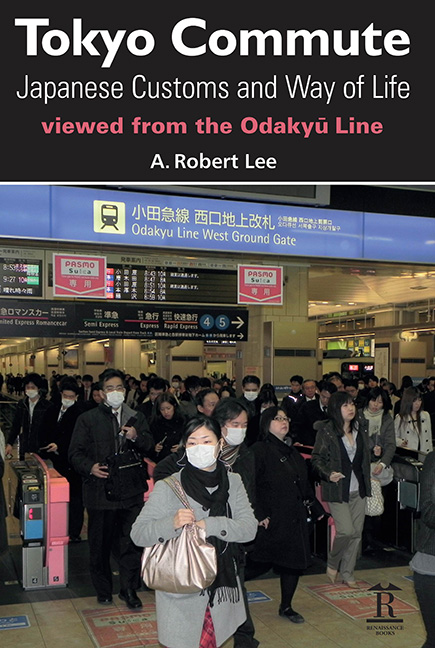Book contents
- Frontmatter
- Dedication
- Acknowledgements
- Contents
- 1 Odakyū-sen
- 2 Shinjuku Station
- 3 Shinjuku
- 4 Mukōgaoka-yūen North
- 5 Mukōgaoka-yūen South
- 6 Mukōgaoka-yūen Platform
- 7 January Monday
- 8 Odakyū Notables
- 9 Odakyū Line Sounds Familiar
- 10 Train Notices
- 11 Odakyū Commercials
- 12 February Tuesday
- 13 Odakyū Keitaispracht
- 14 By-line, Setagaya Line
- 15 March Wednesday
- 16 Odakyū Day-out Sendagi
- 17 Shimo-Kitazawa
- 18 Bicycle!
- 19 Odakyū Bike Interview – Toda-san
- 20 International Interlude via Narita Airport
- 21 Keitai Train Culture
- 22 April Thursday
- 23 Odakyū Tamagawa
- 24 Station Sights
- 25 Odakyū-sen, Yoyogi-Hachiman Eki
- 26 May Friday
- 27 Mukoōgaoka-yūen, Day for Night
- 28 Odakyū Day-out, Hakone
- 29 June Saturday
- 30 Odakyū Commercials
- 31 Odakyū Smokes
- 32 By-line, Nambu Line
- 33 Odakyū Bag Watch
- 34 Seijo Times
- 35 Odakyū Day-out, Yokohama
- 36 July Sunday
- 37 Odakyū Trains of Thought
- 38 Train Signs, Train Sounds
- 39 By-line, Tama Express
- 40 August Monday
- 41 Odakyū Day-out, Chiba
- 42 September Tuesday
- 43 Odakyū Lady-grooming
- 44 Odakyū and Near-Odakyū Women’s Hairday
- 45 Odakyū Evenings-out
- 46 October Wednesday
- 47 Odakyū Day-out, Ibaraki
- 48 Chikan! Odakyū Misbehaviour
- 49 November Thursday
- 50 Odakyū Blues
- 51 Odakyū Men’s Haircut
- 52 Odakyū Day-out, Ō-Sumo
- 53 December Friday
- 54 Odakyū Store
- 55 Odakyū Bookshelf
- 56 Last Train
- Glossary
- Frontmatter
- Dedication
- Acknowledgements
- Contents
- 1 Odakyū-sen
- 2 Shinjuku Station
- 3 Shinjuku
- 4 Mukōgaoka-yūen North
- 5 Mukōgaoka-yūen South
- 6 Mukōgaoka-yūen Platform
- 7 January Monday
- 8 Odakyū Notables
- 9 Odakyū Line Sounds Familiar
- 10 Train Notices
- 11 Odakyū Commercials
- 12 February Tuesday
- 13 Odakyū Keitaispracht
- 14 By-line, Setagaya Line
- 15 March Wednesday
- 16 Odakyū Day-out Sendagi
- 17 Shimo-Kitazawa
- 18 Bicycle!
- 19 Odakyū Bike Interview – Toda-san
- 20 International Interlude via Narita Airport
- 21 Keitai Train Culture
- 22 April Thursday
- 23 Odakyū Tamagawa
- 24 Station Sights
- 25 Odakyū-sen, Yoyogi-Hachiman Eki
- 26 May Friday
- 27 Mukoōgaoka-yūen, Day for Night
- 28 Odakyū Day-out, Hakone
- 29 June Saturday
- 30 Odakyū Commercials
- 31 Odakyū Smokes
- 32 By-line, Nambu Line
- 33 Odakyū Bag Watch
- 34 Seijo Times
- 35 Odakyū Day-out, Yokohama
- 36 July Sunday
- 37 Odakyū Trains of Thought
- 38 Train Signs, Train Sounds
- 39 By-line, Tama Express
- 40 August Monday
- 41 Odakyū Day-out, Chiba
- 42 September Tuesday
- 43 Odakyū Lady-grooming
- 44 Odakyū and Near-Odakyū Women’s Hairday
- 45 Odakyū Evenings-out
- 46 October Wednesday
- 47 Odakyū Day-out, Ibaraki
- 48 Chikan! Odakyū Misbehaviour
- 49 November Thursday
- 50 Odakyū Blues
- 51 Odakyū Men’s Haircut
- 52 Odakyū Day-out, Ō-Sumo
- 53 December Friday
- 54 Odakyū Store
- 55 Odakyū Bookshelf
- 56 Last Train
- Glossary
Summary
BUNRAKU
Ourselves just arrived in Japan. A bow into the magnificent puppet art at the National Theatre of Tokyo. Odakyū Line to Chiyoda (Omotesando), and thence, to the Hanzomon Line and station of the same name. The bunraku on-stage story is Yoshitsune and the Thousand Cherry Trees (Yoshitsune Sembon Zakura), first half in the afternoon performance, the second in the evening. Clan plot-line. Warring brothers, with Yoshitsune as hero. Fox magic. Breathtaking puppetry (the manipulators clothed and hooded in black). Puppets in stylized hyper-colour – white visage, pencil-black eyebrows, sumptuous gowning. Subtly tonal shamisen accompaniment played with plectrum. All speaking parts ventriloquized through the ‘chanter’ (tayū). Earphone English. To follow, later, will be evenings of kabuki at the venerable kabuki-za in Ginza which opened in 1889. Plus at the Nerima Bunka Centre (Odakyū Line then change to Oedo Line to Nerima Station) an evening which combines kyōgen, a brief, episodic theatre-piece called ‘Dondaro’, the story of a husband-wanderer's return, and a stately, meticulous noh performance of a classic folk and fox story. But bunraku it was as a Japan of First Encounter. An inaugural bow into all the several kinds of ‘stage’ Japan. Arigatō.
DINNER
Evening-after-meeting with colleagues and graduate students. Medium-range Japanese-Japanese restaurant. Tatami-mat room. Long low-tables. Cross-legged dining. Oshibori (small hand-cleansing towel) first as in all Japanese eateries. Hashi duly horizontal so as not to point to the diner opposite. After an opening kampai!, brief speeches, and an itadakimasu (‘thank you for the meal’), it is on into eats and drinks. Your legs begin to hint of a realm of the dead. Beer (bottle or nama bīru – draft beer). Sake (rice wine). You pour your neighbour’s, your neighbour pours yours. Drinks-at-the-table mutual aid society? Legs fading. Then, in neatest presentation: otōshi (Japanese amuse-bouche), chawan-mushi (savory custard), yaki-zakana or ni-zakana (grilled or steamed fish), gohan (rice – indispensable), sushi, sashimi, tempura, misoshiru (miso soup), hōji-cha (digestive tea). More speeches still to go and then the san bon jime, the final three-timesover ritual hand clap. By now your legs are lost, in the mortuary. Stretch, massage, miracles, a prayer to the kami (the shinto spirits).
- Type
- Chapter
- Information
- Tokyo CommuteJapanese Customs and Way of Life Viewed from the Odakyū Line, pp. 171 - 176Publisher: Amsterdam University PressPrint publication year: 2011



